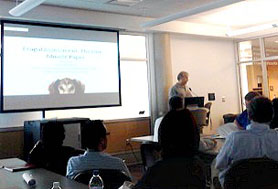One-Minute Paper
October 02, 2014

Mid-term is also a good opportunity for students and instructors to reflect on the class while there is still time to make changes. You may want to ask students to write anonymous course evaluations as part of their homework. You might give them specific questions to respond to: What would you keep about our class? What would you change? What do you want to do more of, Less of? How would you describe the course/the instructor/assignments thus far?
Classroom assessment techniques are formative evaluation methods that help you to assess the degree to which your students understand the course content. They can provide you with information about the effectiveness of your teaching methods as well. During the SIU Assessment Day Conference last Thursday, October 2nd, 2014, Jim Sissom, Associate Professor of Information Systems Technologies, presented his experience in using “one-minute papers” as an assessment tool in his teaching on a daily basis.
For instance, below is a sample of his “Class Exit Ticket” for IST 232-001 System Analysis and Design Tools:
One-Minute Paper:
1. What is the big point, the main idea that you learned in class today?
2. What is the main unanswered question you leave class with today? What is the “muddiest” point?
A “one-minute paper” refers to a very short, usually anonymous, in-class writing activity (taking one-minute or less to complete), where students respond to an instructor-posed question that is designed to provide the instructor with feedback about student learning. This strategy was originally developed by a Physics professor at UC Berkeley in 1983 then popularized by Cross and Angelo in 1988 as one of a wide variety of quick “classroom assessment techniques”. Please talk to Jim for further information if you are interested in a variety of different questions that may be used as prompts for minute papers and multiple advantages associated with minute papers.
